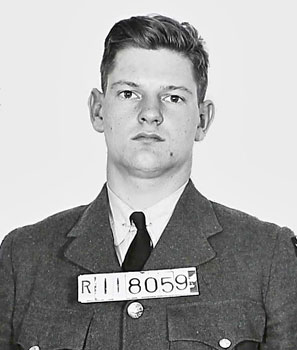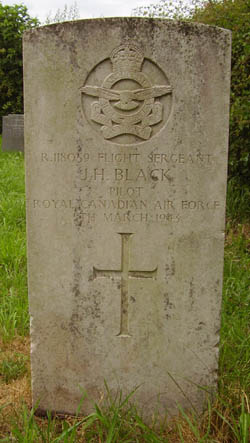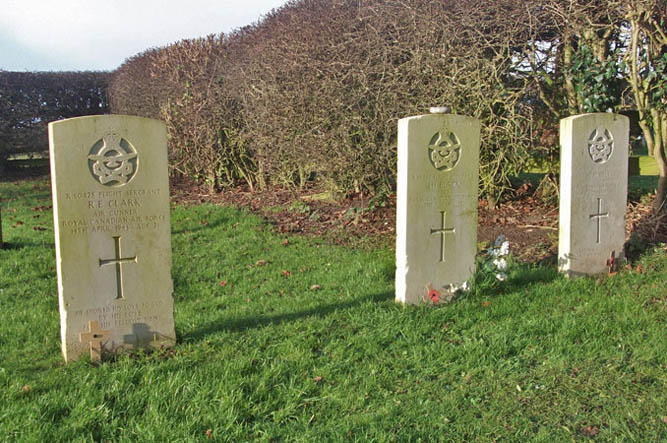Wellington DF624 near Stokesley.
On 21st December 1942 the crew of this 429 Squadron Wellington undertook a night training flight and took off from their base at East Moor at 19.26hrs. Twenty minuted into the flight the aircraft began to suffer an electrical failure which saw the pilot turn around and head back toward East Moor. The aircraft's internal lighting got gradually dim and then failed. The electrical problem also caused the propellers on both engines to go into a fully fine pitch and eventually this then caused the engines to over-rev and eventually to overheat. The crew became uncertain of where they were and once the aircraft had been flying above cloud for some time the crew became uncertain of their position. The aircraft began to slowly lose height and fearing he was loosing control of the aircraft the captain ordered his five crew to abandon the aircraft close to the northern side of the North Yorkshire Moors. At 21.50hrs the crew left the aircraft successfully but some received injuries on landing. The pilot suffered his injuries after landing on a fence. The rear gunner broke his back and may have landed on moorland to the south of where the aircraft eventually crashed near Kirkby, a few miles south of Stokesley. East Moor airfield took charge of the crash site; they sent transport to collect the crew, put a guard on the aircraft and destroyed secret equipment the aircraft was carrying.
Wellington DF624 was built to contract 92439 by Vickers Armstrongs Ltd at Blackpool and was delivered to the RAF in mid-July 1942. It was received by 44 M.U. on 19th July 1942 and remained with them until being taken on charge by 156 Squadron at Alconbury on 16th November 1942. It was soon transferred to 429 Squadron on 8th December 1941, not long after they formed at East Moor on 7th November 1942. It would be the first Wellington MkIII lost by 429 Squadron. After damage assessment following the crash near Stokesley on 21st December 1942 Cat.E2/FA damage was recorded and it was struck off charge on 29th December 1942.
Pilot - F/Sgt John Hannah Black RCAF (R/118059).
Navigator - Sgt Alexander Napier RAF (657875).
Bomb Aimer - Sgt Peter Geoffrey Rothera RAFVR (1387403).
Wireless Operator / Air Gunner - P/O Peter Spencer Bastian RAFVR (126739).
Wireless Operator / Air Gunner - Sgt Harold West RAFVR (948124). Injured.
Air Gunner - Sgt Ronald George Moore RCAF (R/93267). Injured.
John Black was born on 20th February 1920 in Vancouver, British Columbia, Canada and was the son of William Stanley and Louise (nee Miller) Black. As a young man he attended Vancouver Technical School and university before starting work as a shipping clerk for a motor vehicle manufacturer. He enlisted for RCAF service on 11th July 1941 in Vancouver and trained as a pilot in Canada, receiving his Pilot's Flying Badge on 10th April 1942. He was then posted to the UK and trained at 3 (P)AFU and was posted to 29 OTU on 1st September 1942. While at 29 OTU he, Rothera, Moore and Napier formed up as part of a crew and were training together at 29 OTU when they were involved in another flying accident. Wellington X4001 was taking off at North Luffenham for a night flying exercise on 16th November 1942 when it struck a fuel bowser which was inadvertantly crossing the runway due to a misunderstanding on the part of the bowser driver. The aircraft crashed injuring all six on board. All later completed their course at 29 OTU and had all reported to 429 Squadron on 16th December 1942; only a few days prior to their incident detailed above. On 2nd March 1943, F/Sgt Black was also the skipper of Wellington HZ260 with the crew were detailed for a mine laying operation to the Nectarine fields. The aircraft was attacked by the enemy killing one of the crew. The aircraft eventually ditched in the North Sea, 87 miles off Cromer where two of the crew managed to get into the dinghy. The remaining other two crew members sadly did not and went down with the aircraft and were lost. F/Sgt Black and the bomb aimer (Sgt Rothera) had both been in the Wellington at the OTU when it crashed and had baled out of the Wellington near Stokesley a few months previously and now found themselves in a dingy in the middle of the North Sea. Over two days later a ASR aircraft located the two afloat in the North Sea and rescue came, Sgt Rothera was picked up tired but alive, sadly F/Sgt Black had died of exposure a few hours before rescue came and his body was returned to East Moor and he was buried on the 8th March 1942. The service was held at Sutton on Forest village church, both Civilian vicar and RAF padre conducted the service and he was laid to rest at Midday in Huby Road Cemetery, where he still lies.



Sgt Rothera returned to 429 Squadron East Moor, he was to be killed on 4th July 1943 when Wellington LN296 was shot down over Holland. He was initially buried locally in Holland but his remains were taken to Bergen op Zoom War Cemetery after the War ended. He was twenty five years old.
P/O Bastian lost his life on 26th March 1943 when 429 Squadron Wellington MS487 was hit by flak on an operational flight. The aircraft crashed in Holland killing three of the crew. He is buried in The Hague General Cemetery.
Alexander Napier received a commission in early 1944 and appears to have survived the war.